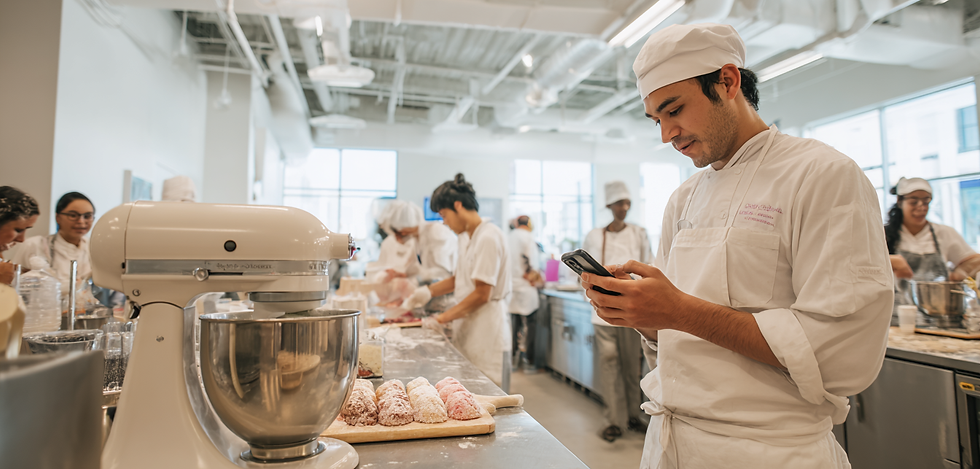
The Creaming Method
A Foundational Technique for Creating Flaky, Tender Baked Goods.
Mixing Air, Fat, and Science
The creaming method is a foundational mixing technique in pastry and baking. It begins by beating room-temperature fat with sugar to incorporate air. This step gives structure and tenderness to many baked goods. From there, eggs are added to create an emulsion. Finally, dry ingredients and liquids are gently mixed in to complete the batter or dough.
The magic of this method lies in the balance between air, fat, and flour—each step affects texture, rise, and flavor.
Step-by-Step
Creaming Procedure

Step 1 - Cream Fat and Sugar
1. Use paddle attachment.
2. Beat on medium until fluffy and pale.
3. Scrape bowl frequently for even texture.
4. This stage traps air, which supports rise.

Step 2 - Add Eggs Slowly
1. Add eggs one at a time.
2. Mix until fully incorporated each time.
3. Scrape bowl to maintain emulsion.
4. Go slow so. Eggs can cause fat to curdle.

Step 3 - Alternate Dry and Wet Ingredients
1. Alternating dry and wet ingredients.
2. Begin and end with dry.
3. Mix on low, just until combined.
4. Overmixing activates gluten = tough texture.

Step 4 - Fold in Garnishes
1. Use spatula to gently fold in garnishes.
2. Avoid deflating the batter.
3. Portion and bake.
Raw Ingredients for the Creaming Method
Each ingredient in the creaming method plays a specific role in flavor, texture, and chemistry.
This section breaks down the function of each key ingredient so you can mix with confidence and troubleshoot with clarity.
Fat
Room temperature butter, margarine, or shortening must be pliable—not melted or cold.
Sugar
Granulated, brown, or liquid sugars aid in aeration.
Eggs
Room temperature whole eggs, yolks, or whites help bind and leaven.
Flour
Low-gluten flours like all-purpose, pastry, or cake flour prevent toughness.
Leavener
Baking soda or powder boosts rise.
Liquid
Milk, fruit juice, or purées add moisture and flavor.
Flavor
Extracts, salt, and zest round out taste.
Garnish
Chopped nuts, chocolate, or dried fruits add texture and interest.
Tricks of the Trade
Here are practical tips that help bakers avoid common mistakes and improve results.
1. Room Temperature Butter
Soft, pliable butter blends evenly with sugar and traps air—creating the lift and texture you want. Too cold and it stays chunky; too warm and it turns greasy. Room temp is just right for the creaming method.
2. Flour to the Rescue
When cold eggs hit creamed butter, the emulsion can break and look like cottage cheese. A spoonful of flour helps bind the mix and restore a smooth texture before adding more ingredients.
3. Paddle Please
No Whisk! Creaming is about smashing fat and sugar together—not whipping air. The paddle blends thoroughly without over-aerating, which keeps the structure of your batter tender and stable.
4. Low-Gluten Flour
Cake and pastry flour have less protein than all-purpose, which means less gluten. Less gluten means a softer, more delicate crumb—perfect for baked goods like cookies, cakes, and tender pastries.
